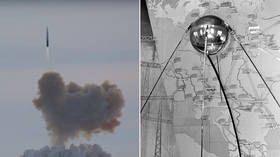Building Avangard hypersonic glider was like launching world’s 1st artificial satellite – Putin

Vladimir Putin has likened development of Russia’s cutting-edge Avangard hypersonic glider to the 1957 launch of Sputnik-1, the world’s first artificial satellite built by the Soviet Union.
The secretive top-notch weapon has demonstrated Russia’s technological capabilities, Putin said in his annual address to the Federal Assembly. “It seemed until recently that Russia can’t make a breakthrough in defense technologies, but we made it,” the president noted.
For instance, developing the Avangard hypersonic glider is matched in importance with the launch of the first artificial satellite.
Little is verifiably known about the glider that was successfully test-launched by the Russian military earlier this year. Top Russian officials threw some light on the secretive project, telling the media that the latest test proved it can travel a whopping 27 Mach, which is equal to over 30,000 km/h or 20,000 mph.
A hypersonic glider is a warhead able to fly through the atmosphere at an exceptionally high speed. China, the US, and Russia are considered the most advanced nations to possess hypersonic technologies, with Moscow claiming it is leading in the race with the Avangard.
The Soviet Union launched the Sputnik-1 into an elliptical low Earth orbit on October 4, 1957, and it orbited for three weeks before its batteries died. Being 58cm (23 inches) in diameter, the Sputnik was equipped with four external radio antennas to broadcast radio pulses.
Subscribe to RT newsletter to get stories the mainstream media won’t tell you.














